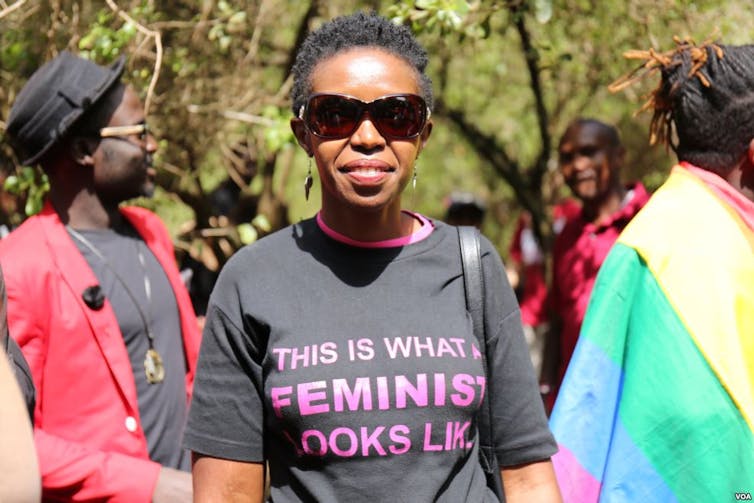Women marching worldwide revive a long-sought dream: global feminism
Women marching worldwide revive a long-sought dream: global feminism

The day after the inauguration of Donald Trump as 45th president of the United States, almost three million women and men marched on the streets nationwide to show their rejection to the demonstrated sexism, xenophobia and Islamophobia of the new American president.
Americans and immigrants in the US were joined in their dissent by citizens on every continent. Thousands of Latin American marchers showed their solidarity across the region, from Mexico to Argentina. Africa and even Antarctica also showed their support.
This international march is a major achievement for the feminist movement. Feminists have finally achieved something the movement has struggled to do for decades: bring together Black, Latino and Indigenous women, the LGBT community, environmental activists, and many others groups under one umbrella.
And in adopting tactics from foreign human rights movements, American organisers and participants demonstrated a rare global and historical awareness.
Women’s rights are human rights
This diverse coalition came out not just to protest Trump’s agenda but to state that women’s rights are human rights, and that the president of the United States is obliged to respect the rights of migrants, Muslims, Latinas and Latinos, people with disabilities and the LGBT community – under domestic and international law.
In Latin America, it was natural that women would take to the streets on this occasion. Women across the region are systematically killed and sexually abused with impunity under the same misogynistic culture that underpinned President Trump’s comments about sexual assault.
The Women’s March adds to the recent women’s movements in Latin America – Ni Una Menos and Paro Nacional De Mujeres (National Women’s Strike) among them – representing what the feminist movement has long aspired to: women’s unity around the world.
Rarely have women’s movements and feminists managed to appeal to other identities. The most visible part of movement has, both intentionally and unintentionally, often excluded those with less privilege, like Latina, Muslim and Black feminists, by championing causes seen as narrow and concerning only white women.
Ditching the ‘nice white lady’ agenda
During the early stages of planning, the organisers of the Women’s March on Washington were accused of forwarding a “nice white lady” agenda that neglected the class, race, gender and religious issues facing non-white women.
But by the end, the march’s list of speakers included not only white feminist activists like Gloria Steinem and celebrities such as Scarlett Johansson and Madonna, but also a long list of Latina, Black and Muslim feminists. Legendary Black feminist Angela Davis, Latina actor America Ferrera, singer Alicia Keys, the Mothers of the Movement representing Black Lives Matter, and Pakistani Muslim activist Hina Naveed all spoke.
The Women’s March on Washington was the first time in history that US women have helped launch an intersectional movement incorporating not only American citizens but also people around the world who are affected by US foreign policy. American women with their pink pussy hats are a symbol of meaningful unity against misogyny, racism, xenophobia and Islamophobia worldwide.
The discourse that minority and women’s rights are human rights framed the movement. Trump has spoken openly against women’s reproductive rights – seeking to restrict abortion access at home and abroad – and seems keen to dismantle the civil rights protecting minorities and migrants.
Despite his background living in liberal, gay-friendly New York City, Trump has has also threatened to appoint Supreme Court justices that oppose the rights of gay, lesbian and transsexual people to marry.
The world did not observe the rise of Trump quietly: it marched along with American women and other minorities. This recalls the way that the world – headed by Americans – in the 1980s and 1990s marched to demand the end of Apartheid in South Africa, and to protest genocide in Argentina, Chile and Guatemala.
Learning from the experts
The global nature and historical roots of the Women’s March were also evident in its tactics. Participants employed human rights strategies well-known in Latin America and Africa, such as naming and shaming.
Boomerangs and spirals – tactics used to mobilise international pressure against states that are violating human rights – were also at play in Washington.
Traditionally these strategies have focused on weak states, on the assumption that Western democracies have the authority to judge the human rights performance of other nations. Today, under Trump, the US is more akin to the rogue state that American scholars have previously described.
The US has long seen itself as exceptional, but Trump’s election has forced Americans to look toward other countries with experience confronting the brand of right-wing populism that Donald Trump now threatens to unleash on the US public.
It is invigorating and inspiring: if these strategies have worked in Latin America and Africa, why shouldn’t they work in the US? The feminist movement is finally going global. That’s good news for Americans, and for people of all genders, all over the world.![]()
Ariadna Estévez, Professor, Center for Research on North America, Universidad Nacional Autónoma de México (UNAM)
This article is republished from The Conversation under a Creative Commons license. Read the original article.

Không có nhận xét nào: